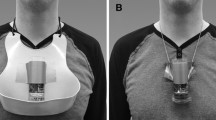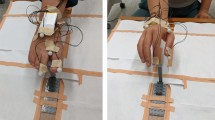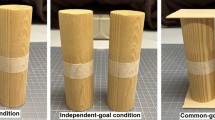Abstract
Previous research has established that the left cerebral hemisphere is dominant for the control of continuous bimanual movements. The lateralisation of motor control for discrete bimanual movements, in contrast, is underexplored. The purpose of the current study was to investigate which (if either) hemisphere is dominant for discrete bimanual movements. Twenty-one participants made bimanual reach-to-grasp movements towards pieces of candy. Participants grasped the candy to either place it in their mouths (grasp-to-eat) or in a receptacle near their mouths (grasp-to-place). Research has shown smaller maximum grip apertures (MGAs) for unimanual grasp-to-eat movements than unimanual grasp-to-place movements when controlled by the left hemisphere. In Experiment 1, participants made bimanual symmetric movements where both hands made grasp-to-eat or grasp-to-place movements. We hypothesised that a left hemisphere dominance for bimanual movements would cause smaller MGAs in both hands during bimanual grasp-to-eat movements compared to those in bimanual grasp-to-place movements. The results revealed that MGAs were indeed smaller for bimanual grasp-to-eat movements than grasp-to-place movements. This supports that the left hemisphere may be dominant for the control of bimanual symmetric movements, which agrees with studies on continuous bimanual movements. In Experiment 2, participants made bimanual asymmetric movements where one hand made a grasp-to-eat movement while the other hand made a grasp-to-place movement. The results failed to support the potential predictions of left hemisphere dominance, right hemisphere dominance, or contralateral control.




Similar content being viewed by others
Notes
Marketed as Smarties in the United States.
References
Amazeen PG (2002) Is dynamics the content of a generalized motor program for rhythmic interlimb coordination? J Mot Behav 34(3):233–251
Ansuini C, Santello M, Massaccesi S, Castiello U (2006) Effects of end-goal on hand shaping. J Neurophysiol 95(4):2456–2465
Ansuini C, Giosa L, Turella L, Altoè G, Castiello U (2008) An object for an action, the same object for other actions: effects on hand shaping. Exp Brain Res 185(1):111–119
Armbrüster C, Spijkers W (2006) Movement planning in prehension: do intended actions influence the initial reach and grasp movement? Mot Control 10(4):311–329
Begliomini C, Caria A, Grodd W, Castiello U (2007) Comparing natural and constrained movements: new insights into the visuomotor control of grasping. PLoS One 2(10):e1108
Benjamini Y, Hochberg Y (1995) Controlling the false discovery rate: a practical and powerful approach to multiple testing. J R Stat Soc Ser B Methodol 57(1):289–300
Bingham GP, Hughes K, Mon-Williams M (2008) The coordination patterns observed when two hands reach-to-grasp separate objects. Exp Brain Res 184(3):283–293
Blinch J, Franks IM, Carpenter MG, Chua R (2015) Unified nature of bimanual movements revealed by separating the preparation of each arm. Exp Brain Res 233(6):1931–1944
Blinch J, Doan JB, Gonzalez CLR (2018) Complexity of movement preparation and spatiotemporal coupling of bimanual reach-to-grasp movements. Exp Brain Res 236(6):1801–1813
Borod JC, Caron HS, Koff E (1984) Left-handers and right-handers compared on performance and preference measures of lateral dominance. Br J Psychol 75(2):177–186
Boulinguez P, Velay J-L, Nougier V (2001) Manual asymmetries in reaching movement control. II: study of left-handers. Cortex 37(1):123–138
Bourne VJ (2006) The divided visual field paradigm: methodological considerations. Later Asymmetr Body Brain Cognit 11(4):373–393
Brown SG, Roy EA, Rohr LE, Bryden PJ (2006) Using hand performance measures to predict handedness. Laterality 11(1):1–14
Bryden PJ, Pryde KM, Roy EA (2000) A performance measure of the degree of hand preference. Brain Cognit 44(3):402–414
Bryden PJ, Mayer M, Roy EA (2011) Influences of task complexity, object location, and object type on hand selection in reaching in left and right-handed children and adults. Dev Psychobiol 53(1):47–58
Byblow WD, Carson RG, Goodman D (1994) Expressions of asymmetries and anchoring in bimanual coordination. Hum Mov Sci 13(1):3–28
Byblow WD, Bysouth-Young D, Summers JJ, Carson RG (1998) Performance asymmetries and coupling dynamics in the acquisition of multifrequency bimanual coordination. Psychol Res 6(1):56–70
Castiello U, Begliomini C (2008) The cortical control of visually guided grasping. Neuroscientist 14(2):157–170
Cavina-Pratesi C, Monaco S, Fattori P, Galletti C, McAdam TD, Quinlan DJ, Goodale MA, Culham JC (2010) Functional magnetic resonance imaging reveals the neural substrates of arm transport and grip formation in reach-to-grasp actions in humans. J Neurosci 30(31):10306–10323
Chapman LJ, Chapman JP (1987) The measurement of handedness. Brain Cognit 6(2):175–183
Cousineau D (2005) Confidence intervals in within-subject designs: a simpler solution to Loftus and Masson’s method. Quant Methods Psychol 1(1):42–45
Davare M, Andres M, Cosnard G, Thonnard JL, Olivier E (2006) Dissociating the role of ventral and dorsal premotor cortex in precision grasping. J Neurosci 26(8):2260–2268
Davare M, Andres M, Clerget E, Thonnard JL, Olivier E (2007) Temporal dissociation between hand shaping and grip aperture force scaling in the anterior intraparietal area. J Neurosci 27(15):3974–3980
de Poel HJ, Peper CL, Beek PJ (2007) Handedness-related asymmetry in coupling strength in bimanual coordination: furthering theory and evidence. Acta Psychol 124(2):209–237
de Poel HJ, Peper CL, Beek PJ (2008) Laterally focused attention modulates asymmetric coupling in rhythmic interlimb coordination. Psychol Res 72(2):123–137
Dohle C, Ostermann G, Hefter H, Freund HJ (2000) Different coupling for the reach and grasp components in bimanual prehension movements. NeuroReport 11(17):3787–3791
Ferri F, Campione GC, Dalla Volta R, Gianelli C, Gentilucci M (2010) To me or to you? When the self is advantaged. Exp Brain Res 203(4):637–646
Fleming J, Klatzky RL, Behrmann M (2002) Time course of planning for object and action parameters in visually guided manipulation. Vis Cogn 9(4–5):502–527
Flindall JW, Gonzales CLR (2014) Eating interrupted: the effect of intent on hand-to-mouth actions. J Neurophysiol 112(8):2019–2025
Flindall JW, Gonzalez CLR (2013) On the evolution of handedness: evidence for feeding biases. PLoS One 8(11):e78967
Flindall JW, Gonzalez CLR (2015) Children’s bilateral advantage for grasp-to-eat actions becomes unimanual by age 10 years. J Exp Child Psychol 133:57–71
Flindall JW, Gonzalez CLR (2016) The destination defines the journey: an examination of the kinematics of hand-to-mouth movements. J Neurophysiol 116(5):2105–2113
Flindall JW, Gonzalez CLR (2017) The inimitable mouth: task-dependent kinematic differences are independent of terminal precision. Exp Brain Res 235(6):1945–1952
Flindall JW, Gonzalez CLR (2019) Wait wait, don't tell me: Handedness questionnaires do not predict hand preference for grasping. Later Asymmetr Body Brain Cognit 24(2):176–196
Flindall JW, Stone KD, Gonzalez CLR (2015) Evidence for right-hand feeding biases in a left-handed population. Laterality 20(3):287–305
Franz EA, Rowse A, Ballantine B (2002) Does handedness determine which hand leads in a bimanual task? J Mot Behav 34(4):402–412
Gonzalez CLR, Goodale MA (2009) Hand preference for precision grasping predicts language lateralization. Neuropsychologia 47(14):3182–3189
Gonzalez CLR, Li F, Mills KJ, Rosen N, Gibb RL (2014) Speech in action: degree of hand preference for grasping predicts speech articulation competence in children. Front Psychol 5:1267
Heuer H, Klein W (2005) Intermanual interactions in discrete and periodic bimanual movements with same and different amplitudes. Exp Brain Res 167(2):220–237
Hunter ZR, Brysbaert M (2008) Visual half-field experiments are a good measure of cerebral language dominance if used properly: evidence from fMRI. Neuropsychologia 46(1):316–325
Jackson GM, Jackson SR, Kritikos A (1999) Attention for action: coordinating bimanual reach-to-grasp movements. Br J Psychol 90(2):247–270
Jeannerod M (1981) Intersegmental coordination during reaching at natural visual objects. In: Long J, Baddeley A (eds) Attention and performance IX. Erlbaum, Hillsdale NJ, pp 153–168
Kandel ER, Schwartz JH, Jessell TM (2000) Principles of neural science, 4th edn. McGraw-Hill, New York
Karabanov AN, Irmen F, Madsen KH, Haagensen BN, Schulze S, Bisgaard T, Siebner HR (2019) Getting to grips with endoscopy—learning endoscopic surgical skills induces bi-hemispheric plasticity of the grasping network. Neuroimage 189:32–44
Kelso JAS (1997) Dynamic patterns: The self-organization of brain and behavior. MIT Press, Cambridge
Kelso JA, Southard DL, Goodman D (1979) On the coordination of two-handed movements. J Exp Psychol Hum Percept Perform 5(2):229–238
Kelso JA, Putnam CA, Goodman D (1983) On the space-time structure of human interlimb coordination. Q J Exp Psychol A 35(2):347–375
Kennedy DM, Rhee J, Shea CH (2016) Symmetrical and asymmetrical influences on force production in 1:2 and 2:1 bimanual force coordination tasks. Exp Brain Res 234(1):287–300
Le A, Niemeier M (2013) A right hemisphere dominance for bimanual grasps. Exp Brain Res 224(2):263–273
Le A, Vesia M, Yan X, Niemeier M, Crawford JD (2014) The right anterior intraparietal sulcus is critical for bimanual grasping: a TMS study. Cereb Cortex 24(10):2591–2603
Marteniuk RG, Mackenzie CL, Jeannerod M, Athenes S, Dugas C (1987) Constraints on human arm movement trajectories. Can J Psychol 41(3):365–378
Martínez-Camblor P, Corral N (2011) Repeated measures analysis for functional data. Comput Stat Data Anal 55(12):3244–3256
Mason AH, Bruyn JL (2009) Manual asymmetries in bimanual prehension tasks: manipulation of object size and object distance. Hum Mov Sci 28(1):48–73
Monno A, Temprado JJ, Zanone PD, Laurent M (2002) The interplay of attention and bimanual coordination dynamics. Acta Psychol 110(2–3):187–211
Morey RD (2008) Confidence intervals from normalized data: a correction to Cousineau (2005). Quant Methods Psychol 4(2):61–64
Naish KR, Reader AT, Houston-Price C, Bremner AJ, Holmes NP (2013) To eat or not to eat? Kinematics and muscle activity of reach-to-grasp movements are influenced by the action goal, but observes do not detect these differences. Exp Brain Res 225(2):261–275
Oldfield RC (1971) The assessment and analysis of handedness: the Edinburgh inventory. Neuropsychologia 9(1):97–113
Pelletier I, Sauerwein HC, Lepore F, Saint-Amour D, Lassonde M (2007) Non-invasive alternatives to the Wada test in the presurgical evaluation of language and memory functions in epilepsy patients. Epileptic Disord 9(2):111–126
Peters M (1981) Attentional asymmetries during concurrent bimanual performance. Q J Exp Psychol 33A(1):95–103
Prichard E, Propper RE, Christman SD (2013) Degree of handedness, but not direction, is a systematic predictor of cognitive performance. Front Psychol 4:9
Ramsay JO, Silverman BW (2005) Functional data analysis, 2nd edn. Springer, New York
Rice NJ, Tunik E, Grafton ST (2006) The anterior intraparietal sulcus mediate grasp execution, independent of requirement to update: new insights from transcranial magnetic stimulation. J Neurosci 26(31):8176–8182
Rice NJ, Tunik E, Cross ES, Grafton ST (2007) On-line grasp control is mediated by the contralateral hemisphere. Brain Res 1175:76–84
Schot WD, Brenner E, Smeets JB (2010) Robust movement segmentation by combining multiple sources of information. J Neurosci Methods 187(2):147–155
Semjen A (2002) On the timing basis of bimanual coordination in discrete and continuous tasks. Brain Cogn 48(1):133–148
Serrien DJ, Ivry RB, Swinnen SP (2006) Dynamics of hemispheric specialization and integration in the context of motor control. Nat Rev Neurosci 7(2):160–166
Sherwood DE (1994) Hand preference, practice order, and spatial assimilations in rapid bimanual movements. J Mot Behav 26(2):123–134
Smaga Ł (2019a) Repeated measures analysis for functional data using Box-type approximation—with applications. REVSTAT Stat J 17(4):523–549
Smaga Ł (2019b) A note on repeated measures analysis for functional data. AStA Adv Stat Anal. https://doi.org/10.1007/s10182-018-00348-8
Steenhuis RE, Bryden MP (1999) The relation between hand preference and hand performance: what you get depends on what you measure. Later Asymmetr Body Brain Cognit 4(1):3–26
Stins JF, Kadar EE, Costall A (2001) A kinematic analysis of hand selection in a reaching task. Later Asymmetr Body Brain Cognit 6(4):347–367
Stone KD, Bryant DC, Gonzalez CLR (2013) Hand use for grasping in a bimanual task: evidence for different roles? Exp Brain Res 224(3):455–467
Stucchi N, Viviani P (1993) Cerebral dominance and asynchrony between bimanual two-dimensional movements. J Exp Psychol Hum Percept Perform 19(6):1200–1220
Swinnen SP, Wenderoth N (2004) Two hands, one brain: cognitive neuroscience of bimanual skill. Trends Cogn Sci 8(1):18–25
Swinnen SP, Jardin K, Meulenbroek R (1996) Between-limb asynchronies during bimanual coordination: effects of manual dominance and attentional cueing. Neuropsychologica 34(12):1203–1213
Treffner PJ, Turvey MT (1996) Symmetry, broken symmetry, and handedness in bimanual coordination dynamics. Exp Brain Res 107(3):463–478
Tunik E, Frey SH, Grafton ST (2005) Virtual lesions of the anterior intraparietal area disrupt goal-dependent on-line adjustments of grasp. Nat Neurosci 8(4):505–511
Walter CB, Swinnen SP (1990) Asymmetric interlimb interference during the performance of a dynamic bimanual task. Brain Cogn 14(2):185–200
Willems RM, Van der Haegen L, Fisher SE, Francks C (2014) On the other hand: including left-handers in cognitive neuroscience and neurogenetics. Nat Rev Neurosci 15(3):193–201
Wilmut K, Byrne M, Barnett AL (2013) Reaching to throw compared to reaching to place: a comparison across individual with and without developmental coordination disorder. Res Dev Disabil 34(1):174–182
Zhang JT, Liang X (2014) One-way ANOVA for functional data via globalizing the pointwise F-test. Scand J Stat 41(1):51–71
Zhang JT, Cheng MY, Wu HT, Zhou B (2019) A new test for functional one-way ANOVA with applications to ischemic heart screening. Comput Stat Data Anal 132:3–17
Acknowledgements
The Natural Sciences and Engineering Research Council of Canada supported this research with a Tier II Canada Research Chair and a Discovery Grant awarded to Claudia Gonzalez and an Alexander Graham Bell Canadian Graduate Scholarship-Doctoral awarded to Jason Flindall. Our thanks to three anonymous reviewers for their insightful critiques.
Author information
Authors and Affiliations
Corresponding author
Ethics declarations
Conflict of interest
The authors declare that they have no conflict of interest.
Ethical approval
All procedures performed in studies involving human participants were in accordance with the ethical standards of the institutional and/or national research committee and with the 1964 Helsinki declaration and its later amendments or comparable ethical standards.
Informed consent
Informed consent was obtained from all individual participants included in the study.
Additional information
Communicated by Carlo Alberto Marzi.
Publisher's Note
Springer Nature remains neutral with regard to jurisdictional claims in published maps and institutional affiliations.
Rights and permissions
About this article
Cite this article
Blinch, J., Flindall, J.W., Smaga, Ł. et al. The left cerebral hemisphere may be dominant for the control of bimanual symmetric reach-to-grasp movements. Exp Brain Res 237, 3297–3311 (2019). https://doi.org/10.1007/s00221-019-05672-2
Received:
Accepted:
Published:
Issue Date:
DOI: https://doi.org/10.1007/s00221-019-05672-2




